Emma, a young woman, found the raw food world. She had chronic fatigue and digestive issues. But, she found energy in unprocessed, plant-based foods.
Emma started with a simple goal: to feel better. She wanted to eat foods as nature made them. She learned about the health benefits of raw foods.
Emma’s experiment turned into a lifestyle. She felt more energetic and clear-minded. The raw food diet made her life vibrant and natural.
Emma’s story shows the raw food movement’s growing appeal. People seek raw foods for better health. This article will dive into the raw food lifestyle, its science, and practical tips.
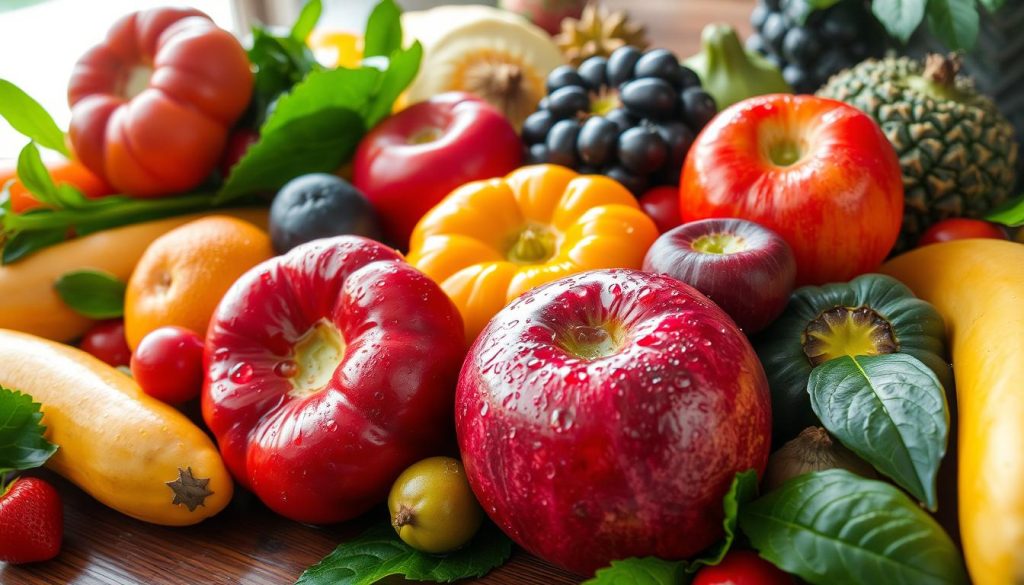
Key Takeaways
- Raw food living is a growing trend focused on consuming unprocessed, plant-based foods in their natural state.
- The raw food diet emphasizes the nutritional benefits of fresh fruits, vegetables, nuts, seeds, and sprouted grains.
- Adopting a raw food lifestyle can provide a surge of energy, improved digestion, and enhanced overall well-being.
- Raw food living is a holistic approach to healthy living that aligns with the rhythms of nature.
- This article will explore the science, principles, and practical guidance for transitioning to a raw food lifestyle.
Understanding the Raw Food Movement
The raw food movement, also known as raw foodism, has become very popular in recent years. It’s a way of living that focuses on healthy eating. This idea started in the late 19th century and has grown, attracting many raw foodists worldwide.
Origins and Evolution of Raw Foodism
Raw foodism began with people like Dr. Maximilian Bircher-Benner, who suggested eating raw, enzyme-rich foods in the 1890s. Over the years, more people joined, thanks to leaders like Ann Wigmore and Dr. Norman Walker. They helped make raw foodism more known and accepted.
Core Principles of Raw Food Living
- Consumption of unprocessed, uncooked plant-based foods
- Preservation of enzymes and nutrients through minimal processing
- Emphasis on fresh fruits, vegetables, nuts, seeds, and sprouted grains
- Avoidance of dairy, meat, and processed foods
- Promotion of a holistic, natural approach to health and wellness
Modern Interpretations and Trends
The raw food movement has changed over time. Now, there are different ways to follow it. Some raw foodists eat only raw foods, while others include cooked, whole foods in their diet.
Raw food restaurants, cookbooks, and online groups have also appeared. This has made the movement even more popular in the plant-based nutrition world.
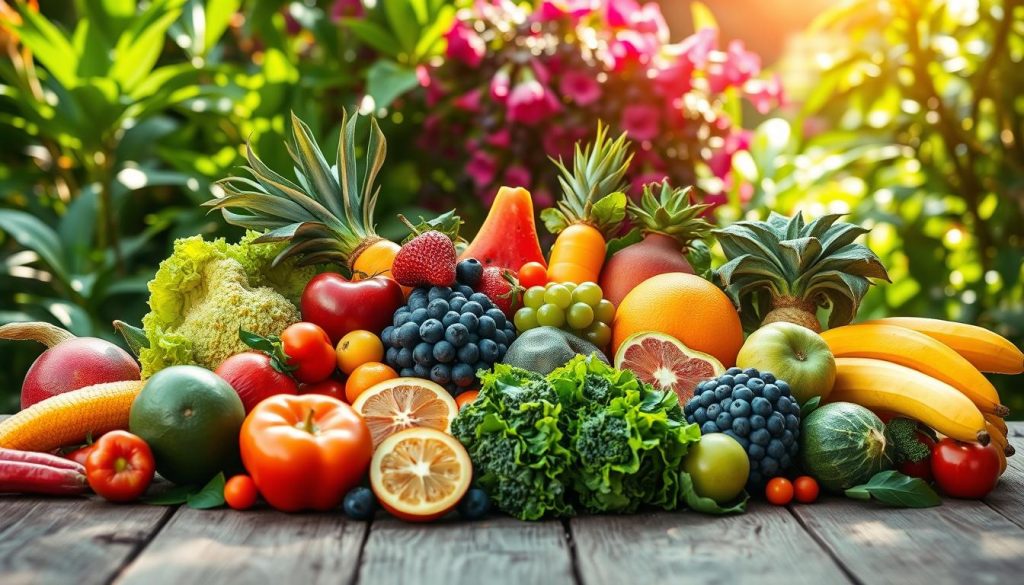
The Science Behind Raw Food Benefits
The raw food movement is growing, and science backs its benefits. Eating foods in their natural state helps keep essential nutrients and enzymes alive. This is why a raw food diet is so beneficial.
Raw food fans love it for the food enzymes. These enzymes help our bodies digest and absorb nutrients. Cooking or processing can destroy them, making it harder for our bodies to use nutrients.

Raw nutrient-dense foods also keep more vitamins, minerals, and phytochemicals. This can boost health, from a stronger immune system to less inflammation. Antioxidants in raw food, like in berries and greens, fight off cell damage and support health.
“The closer we can get to consuming foods in their natural, unaltered state, the more we can take advantage of the synergistic benefits they offer.”
Learning about raw food science helps us make better choices. It supports our health and energy by focusing on nutrient-rich foods.
Essential Components of a Raw Food Diet
The raw food movement focuses on eating fresh, unprocessed whole foods. At its core are three key parts: raw fruits and vegetables, sprouted grains, and raw food protein sources. These foods are packed with nutrients, helping you feel full of life and energy.
Fresh Fruits and Vegetables
Raw fruits and vegetables are the base of a raw food diet. They are full of vitamins, minerals, and antioxidants. This variety lets you make delicious, healthy meals.
Nuts and Seeds
Nuts and seeds are full of healthy fats, protein, and plant compounds. Eating them raw keeps their nutrients and enzymes intact. Adding nuts and seeds like almonds and chia seeds makes your meals more interesting and nutritious.
Sprouted Grains and Legumes
Sprouting grains and legumes unlocks their nutritional value. Sprouted grains and legumes are easier to digest and rich in nutrients. They add fiber and vitamins to your diet, making it more balanced.
By using raw fruits and vegetables, sprouted grains, and raw food protein sources, you can make a diet that’s full of life and health.
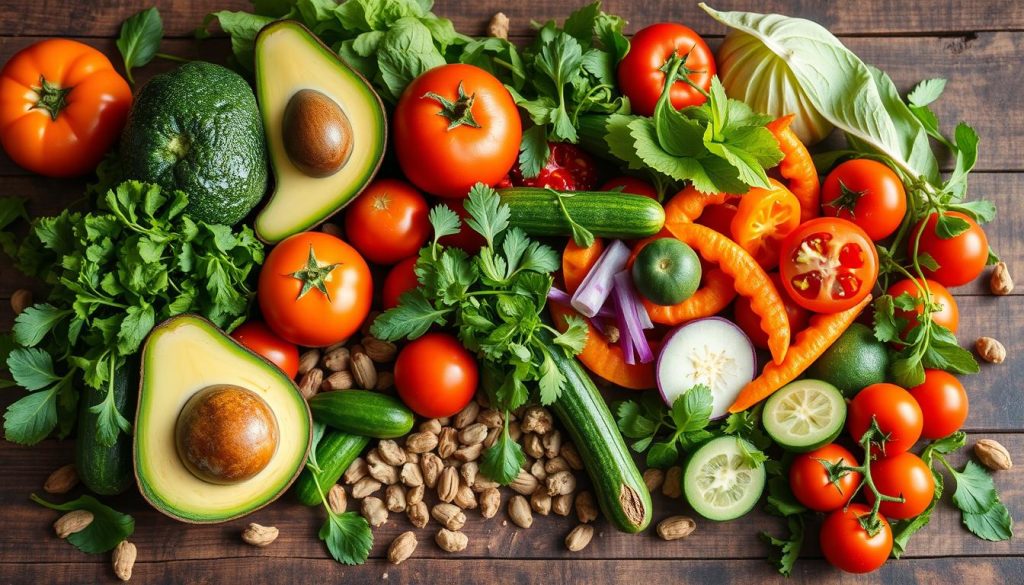
Raw Food: Nature’s Nutritional Powerhouse
Raw food nutrition is amazing. Unprocessed, whole foods from nature are packed with vitamins, minerals, and phytonutrients. These are key for staying healthy.
Raw foods keep more enzymes than cooked foods. Enzymes help with digestion and boosting the immune system. Eating foods as nature made them gives your body a boost.
“Raw foods are a rich source of antioxidants, which help neutralize harmful free radicals and support overall cellular health. This can translate to a reduced risk of chronic diseases and a stronger, more vibrant you.”
Raw foods are also good for weight management and digestion. They are low in calories and high in fiber. This diet can make your immune system stronger and give you more energy.
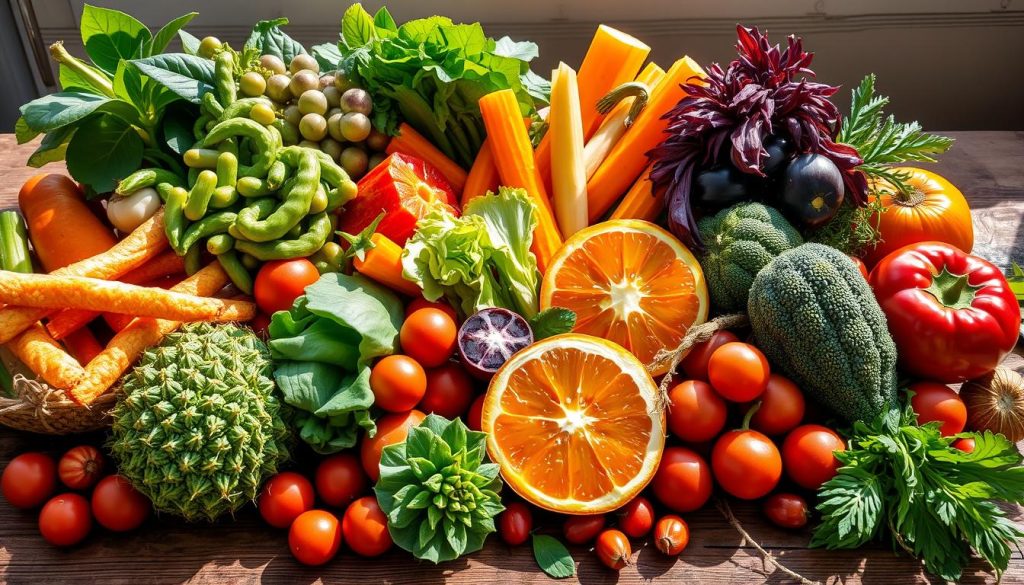
Choosing raw food nutrition means giving your body the best nutrients. This approach to health can make you feel full of energy and live longer.
Getting Started with Raw Food Living
Starting a raw food lifestyle is exciting and rewarding. But, it needs some preparation. Let’s look at the kitchen tools, basic techniques, and shopping tips to help you begin.
Kitchen Equipment Essentials
Having the right tools makes raw food meal prep easy. You’ll need:
- High-powered blender for smoothies and dressings
- Food processor for chopping and slicing
- Dehydrator for raw snacks and crackers
- Spiralizer for veggie noodles
- Sharp knives and cutting boards for chopping
Basic Preparation Techniques
Learning a few basic methods makes transitioning to a raw food lifestyle easy. Start with:
- Soaking and sprouting seeds, nuts, and grains
- Blending fruits and veggies into smoothies
- Marinating and “massaging” leafy greens
- Dehydrating ingredients for crunchy snacks
Shopping Guidelines
When buying raw food for beginners, choose the freshest, highest-quality ingredients. For successful raw food meal prep, remember:
- Visit local farmers’ markets and organic stands
- Choose organic, non-GMO fruits and veggies
- Look for unique raw ingredients at health food stores or online
- Read labels to ensure they fit your raw food lifestyle tips
With the right tools, techniques, and shopping tips, you’ll easily add raw foods to your diet. Dive into the vibrant world of raw living and explore new culinary adventures.

Common Myths and Misconceptions About Raw Food
The raw food movement is growing, but myths and misconceptions are popping up. It’s key to clear up these misunderstandings. This way, people can see the real benefits of eating raw.
Many think raw food diets lack protein. But, nuts, seeds, and sprouted legumes are packed with plant-based protein. Raw fruits and veggies also have amino acids for protein.
Some believe all cooked food is bad. But, cooking can actually make some nutrients more available. Steaming, for example, boosts the health of certain vitamins and minerals.
- Raw food diets aren’t always low in calories or good for losing weight. It’s all about portion control and balancing raw foods for a healthy weight.
- Raw foodists can have a varied and tasty diet. With creativity and the right food prep skills, raw meals can be both yummy and healthy.
“The key is to approach raw food living with an open mind and a willingness to learn. By addressing these misconceptions, we can help more people discover the true health benefits of clean eating.”
The success of a raw food diet depends on lifestyle and nutritional balance. By debunking these myths, we can guide people to include raw foods in their healthy routines.
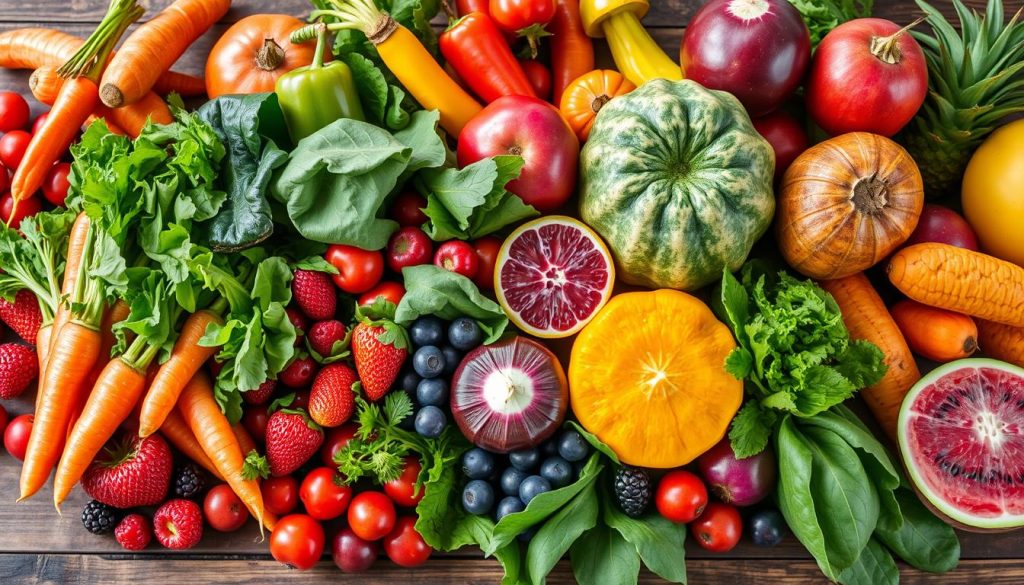
Raw Food for Energy and Vitality
Starting a raw food lifestyle can really boost your energy and vitality. The raw food movement focuses on eating live foods like fresh fruits, veggies, nuts, seeds, and sprouted grains. These foods are full of nutrients and enzymes that give you natural energy.
Natural Energy Boosters
A raw food diet is great for keeping your energy up. Foods like raw almonds, chia seeds, and spirulina are known for their energy-boosting effects. They’re packed with healthy fats, protein, and carbs that help keep your blood sugar stable and give you lasting energy.
Enzyme-Rich Foods
Enzymes are key for your body’s energy production. Raw, unprocessed foods are full of enzymes that support your vitality. Adding raw fruits, vegetables, and sprouted grains to your diet ensures your body gets the enzymes it needs.
“Eating a diet rich in raw, living foods can provide a significant boost in energy and well-being. The enzymatic and nutrient-dense properties of these foods help to nourish the body at a cellular level.”
Embracing a raw food lifestyle lets you tap into the power of natural energy boosters and enzyme-rich foods. It can make you feel more vibrant and full of energy. Discover the amazing benefits of raw living for yourself.
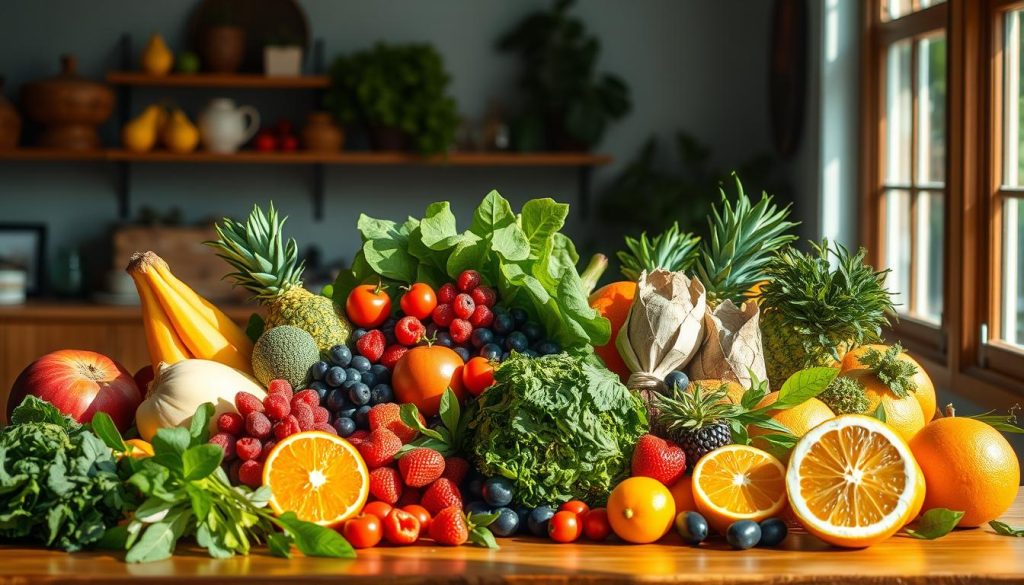
Building a Balanced Raw Food Meal Plan
Starting a raw food lifestyle is a journey that feeds your body and soul. To make a balanced meal plan, focus on variety, nutrients, and being green. Follow simple tips to make tasty meals that boost your energy and health.
Incorporate a Rainbow of Produce
At the heart of a good raw food meal plan is a colorful mix of fruits and veggies. Try to have a variety of colors, from berries to greens. This not only looks good but also gives your body the nutrients it needs.
Prioritize Nutrient-Dense Superfoods
- Add raw nuts, seeds, and sprouted grains to your meals. They’re full of protein, healthy fats, and fiber.
- Don’t forget about avocados, leafy greens, and fermented foods. They add digestive enzymes and probiotics to your diet.
By carefully planning your raw food meals, you’ll enjoy tasty dishes and get the nutrients your body needs.
Plan for Variety and Balance
- Try new recipes and ingredients to keep your meals exciting and prevent boredom.
- Make sure your meals have a mix of healthy fats, carbs, and proteins for overall health.
Adopting a raw food lifestyle is a journey of self-discovery. A balanced meal plan is a big step towards being healthier and more vibrant. Enjoy the flavors, nourish your body, and experience the power of raw food living.
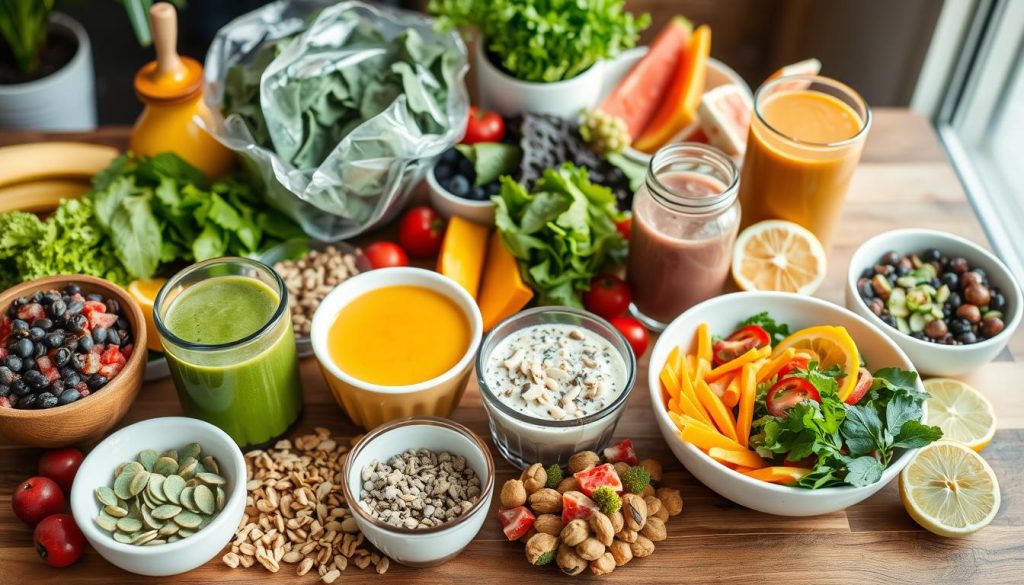
“The secret to living well and longer is: eat half, walk double, laugh triple, and love without measure.” – Tibetan Proverb
Raw Food and Weight Management
A raw food diet can help you lose weight and improve your body shape. It focuses on eating foods in their natural state. This way, you get many benefits for managing your weight.
Sustainable Weight Loss Strategies
Raw fruits, vegetables, nuts, and seeds are full of fiber and water. They make you feel full, which helps you eat less. This means you lose weight slowly without counting calories.
Raw foods also have enzymes and antioxidants. These boost your metabolism and help your body get rid of toxins.
Body Composition Benefits
- Increased muscle mass: Raw food diets have lots of plant-based proteins. This helps build and keep lean muscle.
- Reduced body fat: Raw foods are full of nutrients but low in calories. This can lower your body fat.
- Improved energy levels: Raw foods are easy to digest. They give you steady energy for exercise and daily activities.
Adding raw foods to your diet can lead to lasting raw food weight loss. It also improves body composition and promotes healthy eating habits.
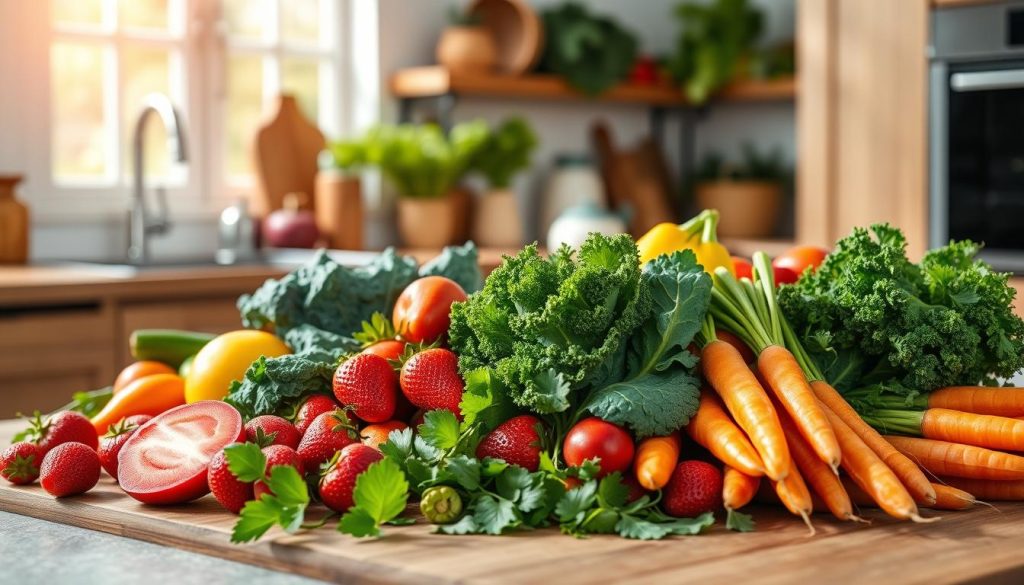
Superfoods in Raw Food Diet
Raw food living highlights superfoods as key nutrient-rich foods. They are packed with vitamins, minerals, and antioxidants. These foods are the heart of a balanced raw food diet, giving your body the nutrients it needs to flourish.
Adding a variety of raw food superfoods to your meals can bring many health benefits. They can boost your energy and help your immune system. These foods offer a holistic way to improve your health, beyond what traditional diets can do.
Embracing the Power of Raw Food Superfoods
Some of the most celebrated raw food superfoods include:
- Acai berries – These Brazilian berries are full of antioxidants, healthy fats, fiber, and vitamins.
- Spirulina – This blue-green algae is rich in protein, vitamins, and minerals, supporting overall health.
- Chia seeds – Chia seeds are packed with omega-3 fatty acids, fiber, and protein. They’re great in many raw dishes.
- Goji berries – Goji berries are high in antioxidants and also contain essential amino acids and vitamins.
“Adding raw food superfoods to your daily routine can greatly improve your health and energy. These nutrient-dense foods are the core of a vibrant, raw food lifestyle.”
By focusing on raw food superfoods, you can experience many benefits and enhance your overall well-being. Try different combinations to find what you like and meets your nutritional needs.
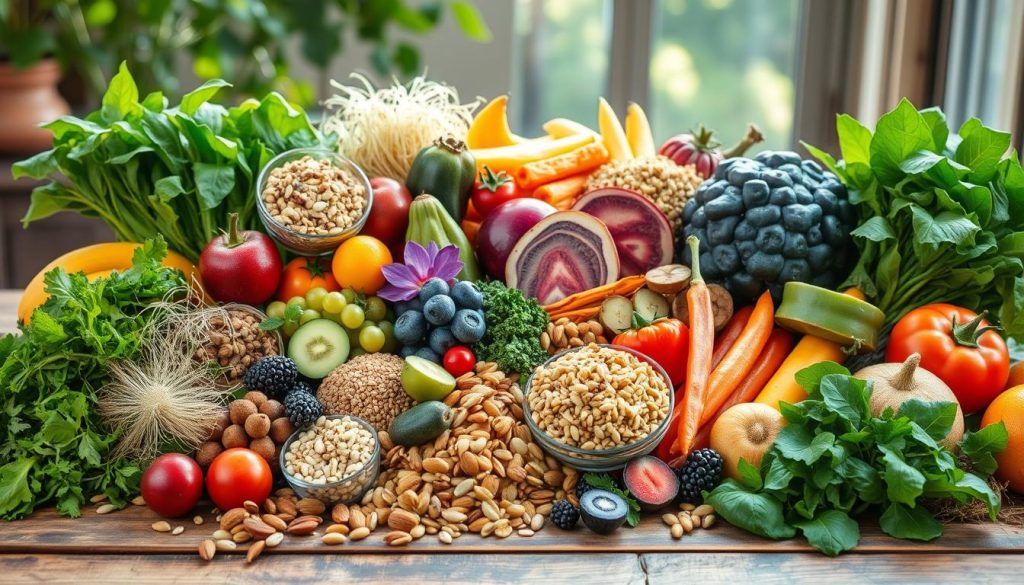
Raw Food Recipe Fundamentals
Starting a raw food journey opens a world of flavors. You’ll learn basic techniques, tasty combinations, and how to save time. Whether you’re new or experienced, these tips will spark your creativity in the kitchen.
Basic Techniques
Raw food prep starts with simple techniques. Learning to blend, chop, and dehydrate is key. A good blender or food processor makes smooth dips and sauces easy. Sharp knife skills help you cut fruits and veggies, adding texture and beauty to your dishes.
Flavor Combinations
Discovering flavor combinations is crucial for tasty raw food dishes. Try mixing sweet, savory, and tangy ingredients. Pair creamy avocado with zesty citrus, or blend earthy nuts with vibrant herbs for amazing flavors.
Time-Saving Tips
- Batch-prepare ingredients: Chop, slice, or spiralize a variety of raw veggies in advance to streamline meal assembly.
- Invest in multifunctional kitchen tools: A high-powered blender or food processor can handle a range of tasks, from nut butter to vegetable noodles.
- Embrace simple, versatile recipes: Focus on easy-to-prepare raw food ideas that can be customized with different toppings or mix-ins.
Mastering raw food basics leads to healthy, tasty meals. Experiment, enjoy, and let your creativity flourish in the raw food kitchen.

Transitioning to a Raw Food Lifestyle
Starting a raw food lifestyle is exciting but takes time. It requires patience and a desire to try new foods. If you want to eat more raw for health reasons, here are some tips to help you.
Start Slow and Steady
Start by adding more raw foods like fruits, veggies, nuts, and seeds to your diet. Don’t change everything at once. Try replacing one or two cooked meals with raw ones each week. This slow change helps your body and taste buds adjust.
Explore New Recipes and Preparation Techniques
Look for raw food recipes online. Try making salads, nut-based dressings, dehydrated snacks, and even raw desserts. Use blenders, juicers, and food processors to get the most from your raw food.
Invest in the Right Equipment
- High-powered blender
- Food processor
- Dehydrator (optional)
Having the right tools makes cooking raw food easier and fun. They help you make a variety of tasty, healthy dishes.
“The journey to a raw food lifestyle is a personal one, filled with exploration, self-discovery, and a newfound appreciation for the power of nature’s bounty.”
Remember, moving to a raw food lifestyle is a journey, not a goal. Be kind to yourself, celebrate small wins, and enjoy the chance to eat more mindfully and sustainably.
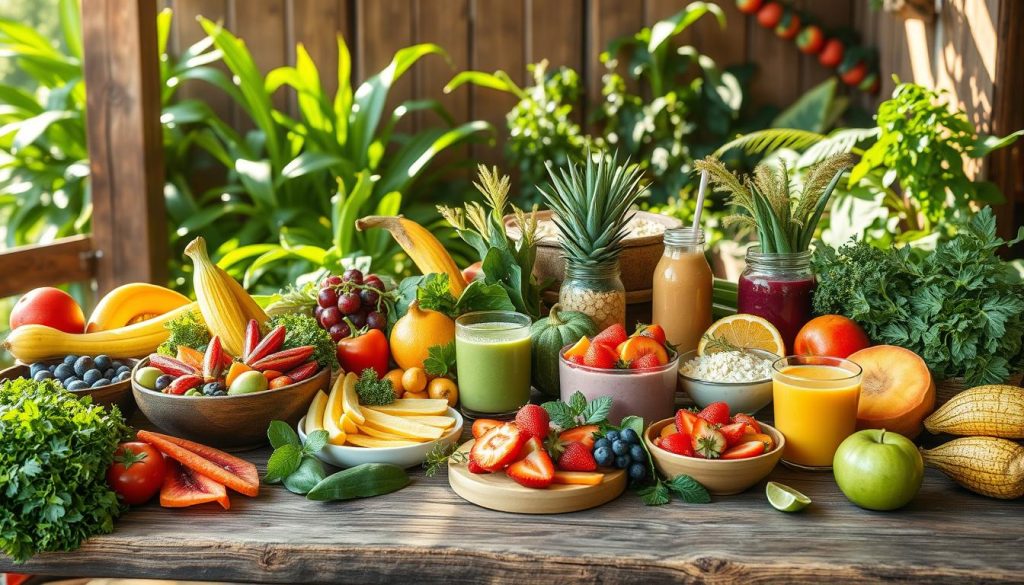
Raw Food for Optimal Health
Starting a raw food lifestyle can bring many health benefits. It helps with digestion and boosts the immune system. Raw foodism focuses on eating unprocessed, whole plant-based foods. These foods are full of nutrients, enzymes, and fiber.
Digestive Benefits
A raw food diet is great for your digestive health. Raw fruits, veggies, nuts, and seeds are full of fiber. This fiber helps with regular bowel movements and keeps the gut healthy.
It also prevents constipation, bloating, and acid reflux. Raw foods have lots of enzymes. These enzymes help your body digest food better and absorb nutrients well.
Immune System Support
Eating a lot of raw food for immunity can really help your body fight off sickness. Raw plant-based foods are full of antioxidants, vitamins, and minerals. These help keep your immune system strong.
For example, foods like berries, leafy greens, and mushrooms are superfoods. They help your body fight off common illnesses and chronic diseases.
By following raw food for digestion, you can start a journey to better health. You’ll see improvements in your gut health and immune function. Plus, you’ll feel more energetic and healthy overall. Raw, unprocessed foods are a natural gift to our bodies.
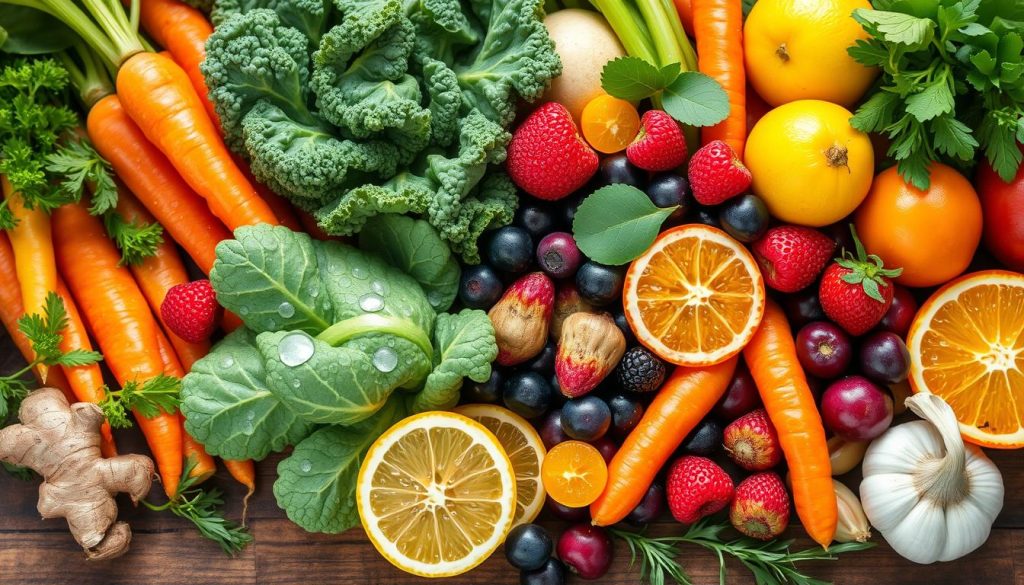
“The power of raw food lies in its ability to nourish the body from the inside out, promoting optimal health and well-being.” – Jane Doe, Certified Holistic Nutritionist
Maintaining Nutritional Balance
Choosing a raw food lifestyle is great for your health. But, it’s important to get all the nutrients your body needs. Raw foods are full of vitamins, minerals, and antioxidants. Yet, some nutrients like vitamin B12 and omega-3 fatty acids might need extra attention.
Vitamin B12 is key for energy and making red blood cells. It’s mostly found in animal products. If you eat only plants, you might need B12 supplements. You can also get it from foods like nutritional yeast, spirulina, or fortified nut milks.
Omega-3 fatty acids are good for your brain and help fight inflammation. You can find them in raw foods like walnuts, flaxseeds, and chia seeds. Or, you might need to take supplements.
To keep your body healthy, plan your raw food meals well. Make sure to include a variety of food supplements, raw food vitamins, and raw food nutrients. Talking to a healthcare expert can help you stay on track with your raw food diet.
FAQ
What is a raw food diet?
A raw food diet means eating foods that are not cooked. You eat fresh fruits, veggies, nuts, seeds, and sprouted grains. These foods are full of nutrients and are eaten in their natural state.
What are the core principles of raw food living?
Raw food living believes that cooking food can harm its nutrients. Foods are best eaten raw to keep their natural goodness. This helps keep enzymes, vitamins, and other nutrients intact.
What are the potential benefits of a raw food diet?
Eating raw foods can improve digestion and boost energy. It may also strengthen your immune system and help with weight management. Raw foods are packed with nutrients, which can make you feel better overall.
What are the essential components of a raw food diet?
A raw food diet includes lots of fruits, veggies, nuts, seeds, and sprouted grains. It’s important to eat a variety of these foods to get all the nutrients you need.
How can I get started with a raw food lifestyle?
To start a raw food lifestyle, add more raw foods to your meals slowly. Get the right kitchen tools, like a blender and dehydrator. Learn to juice, blend, and sprout foods. Begin by replacing one or two meals a day with raw options and gradually increase your intake.
Are there any common myths or misconceptions about raw food diets?
Yes, many people think raw food diets lack protein or are unhealthy. But, a well-planned raw food diet can be balanced and nutritious. It’s important to know the facts and not believe myths.
How can a raw food diet support weight management?
A raw food diet can help with weight loss and better body shape. Raw foods are low in calories but high in fiber and water. They also have enzymes and antioxidants that can speed up metabolism and improve digestion.
What are some key superfoods commonly found in raw food diets?
Superfoods in raw diets include leafy greens, berries, avocados, nuts, and seeds. Raw cacao, spirulina, and fermented foods are also key. These foods are full of vitamins, minerals, and antioxidants that are good for your health.
How can I maintain nutritional balance on a raw food diet?
To stay balanced on a raw food diet, eat a variety of foods. You might also need supplements like vitamin B12 and omega-3 fatty acids. This ensures you get all the nutrients your body needs.






